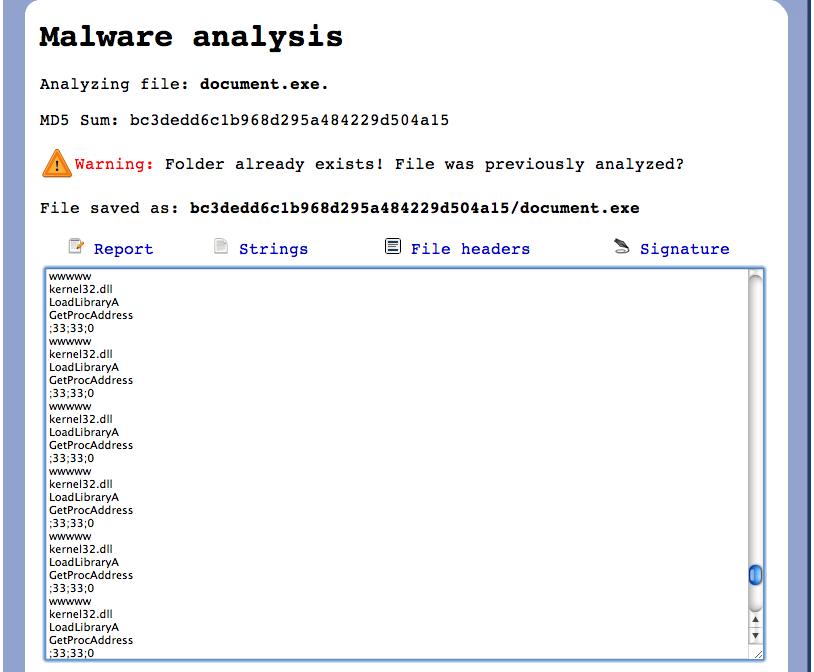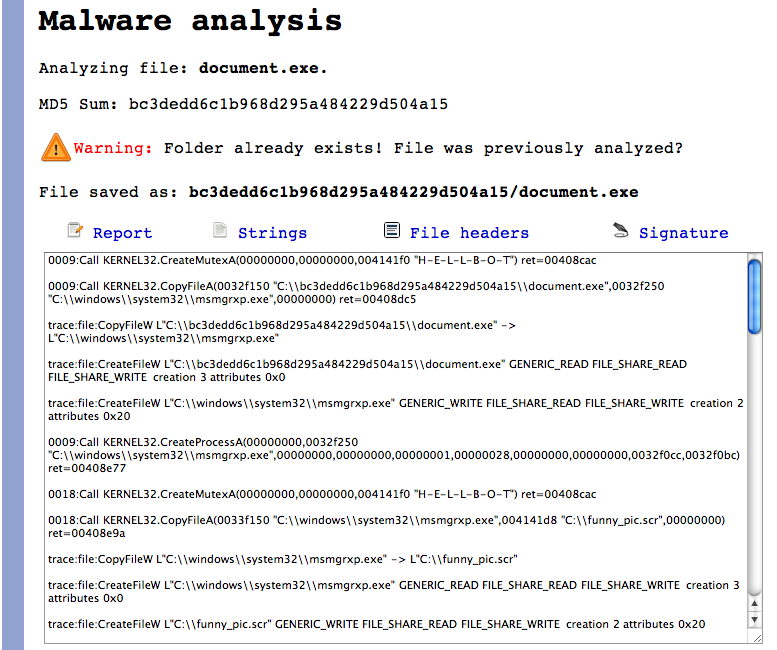Introduction
Zero wine is an open source (GPL v2) research project to dynamically analyze the behavior of malware. Zero wine just runs the malware using WINE in a safe virtual sandbox (in an isolated environment) collecting information about the APIs called by the program.
The output generated by wine (using the debug environment variable WINEDEBUG) are the API calls used by the malware (and the values used by it, of course). With this information, analyzing malware's behavior turns out to be very easy.
How does it works?
Zero wine is distributed as one QEMU virtual machine image with a Debian operating system installed. The image contains software to upload and analyze malware and to generate reports based on the information gathered (this software is stored in /home/malware/zerowine).
Running the distributed virtual machine with the correct command line options (use the supplied startup shell script to run the virtual machine) provides a web based (web server is written in python) graphical interface to upload malware to be analyzed (a CGI written, also, in python).
When a new malware is uploaded, it is copied to the directory /tmp/vir/MD5_OF_THE_FILE, them, the previous created WINE environment (WINEPREFIX if you prefer) is removed and a backup system is untared (the backup system is /home/malware/backup/backup.tar.gz). After this operation, the malware is executed using the shell script malware_launcher.sh (the file is stored in the folder /home/malware/bin).
NOTE: The current system is subject to change as it doesn't allow the analysis of more than one malware at a time. In the future, every time you upload a new malware file it will be added to a queue for later analysis and a new WINEPREFIX specific to run this malware will be created.
Running the virtual machine with QEMU
You must run the virtual machine using QEMU giving various arguments. The most important one is the following: -redir tcp:8000::8000. This parameter redirects the local 8000 port to the port 8000 of the virtual machine. You can, of course, change the port but note that you shouldn't run it at port 80 in Unix/Linux based environments as it needs root privileges, opening a big security hole (imagine the malware escaping from the virtual machine and owning your real system).
When the virtual machine finish the booting process (wait about 2 minutes or so to the Debian based operating system to boot) you can navigate with your preferred browser to http://localhost:8000. You will be received with the following very simple web page:

Just upload your test (PE) file to the virtual machine through the web interface, specify the timeout and let zero wine analyze the program's behavior. After a while a report's summary like the following one will be generated:

Interpreting reports
When the analysis finishes, a report's summary page with 4 links (at the moment of writing this little article) appears. The links are “Report”, “Strings”, “Headers” and “Signature”. The options are explained in the next sections.
Complete Report
The very first link is the Report link. This option shows the complete raw trace file generated by WINE. This file is normally very big and hard to follow (there are too many APIs used by WINE itself mixed with the APIs called by the malware), however, it might help you understand completely what the program does.
The following is a sample report for the virus MyTob (as you might see it's very long and, as so, hard to understand).

Too many API calls (generally, internal WINE calls) that are just junk calls, uninteresting in general for us. Anyway, remember that they might help you understanding the malware you're analyzing even when various calls appears to be uninteresting.
Strings
The output of the Linux command “strings”. Sometimes (in stupid easy to understand malware) you might discover interesting strings, URLs, and so on... The following is an example (MyTob):

File Headers
This report shows the tool used to pack the program if any (using the signatures from PEIdSignatures) and the full output of analyzing the given PE program with the open source library PEFile. The report generated will be similar to the following image:

In this example the header seems to be corrupted, a signal of malware trying to make disassembling harder.
Signature
This is the most interesting report generated by zero wine (when the malware runs OK). This report shows the most interesting API calls and the values used. Easier to see in the following example:

The "Signature" report tells us that the malware created the mutex "H-E-L-L-B-O-T" (process id 0009) and copied itself to c:\windows\system32\msmgrxp.exe. Next, the copied file is executed (process 0018). This copy of the malware checks for the mutex "H-E-L-L-B-O-T" and, if it already exists, copies the binary to c:\\funny_pic.scr and to other various places.
Enough information to write a simple behavior report.
Common Problems
Packers
Zero wine runs malware quite well overall, however, it has problems with various packers (in example, wine fails almost always with PE programs packed with Armadillo) and sometimes you will get no data for both “Report” and “Signature” sections. Anyway, the “Headers” and “Strings” report's sections will appear giving you interesting information about the binary (although not the behavior of the malware).
Detection
Detection of the WINE environment demonstrated to be extremely easy. In example, the registry key HKLM\Software\Wine or HKCU\Software\Wine can be opened to detect it. Another example: Check the file size of any Windows critical system file. When running under WINE, the files will be ridiculously small, while in a real Windows system it will have a (always) bigger size.
Another “advanced” detection technique: Open any critical Windows file and decompile the entry point. When running under WINE the function will decompile to the following 2 simple instructions:
.text:10001000 public start
.text:10001000 start proc near
.text:10001000 mov eax, 1
.text:10001005 retn 4
.text:10001005 start endp
For the lazy people: Just search for the following binary string B8 01 00 00 00 C2 04 00 at .text:10001000.
Dangers
First of all, remember, RUNNING MALWARE IN YOUR COMPUTER IS ALWAYS A BAD IDEA. You must isolate the virtual machine (or the real hardware box) from the real world when possible. Sometimes it's mandatory to allow the malware to connect to the real world, however, you might be attacking other people.
And, what is more important, remember, a malware written to escape the WINE sandbox will escape (even when the WINE's sandbox is configured with only the C: drive) and it might affect your network, your real machines.
Download
Download zerowine (as a prebuilt virtual machine for QEmu or the python source code) from here.
References
Project's web page: http://sourceforge.net/projects/zerowine
WINE: http://www.winehq.org
QEMU: http://bellard.org/qemu/
PEFile by Ero Carrera: http://code.google.com/p/pefile/
PEIdSignatures: http://code.google.com/p/pefile/wiki/PEiDSignatures
PEId: http://www.PEiD.info/
Python: http://www.python.org
Contact Information
Author: Joxean Koret
E-Mail: <admin@joxeankoret.com>
Professional Website: http://www.joxeankoret.com